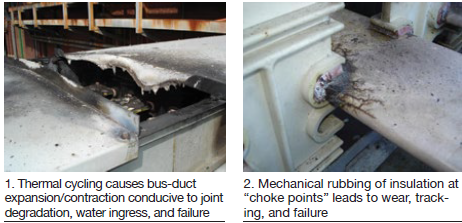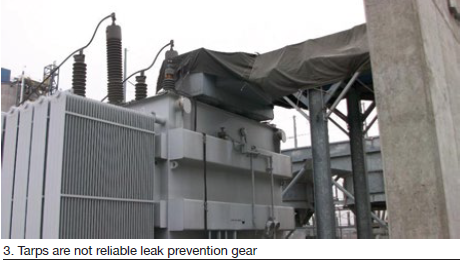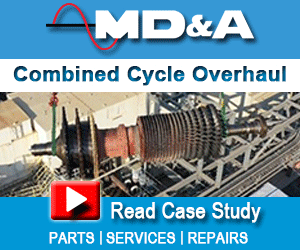In 7EA Users lingo, “roundtable” is essentially a panel discussion. The 2017 meeting of the 7EA Users Group featured two two-hour roundtables, one on bus duct, the other on rotor life management.
The way these sessions are arranged, participating vendors are seated at the front of the meeting room, owner/operators in the audience. To begin, each of the vendors reviews its capabilities on the topic at hand and after introductory comments are completed the moderator, a member of the group’s steering committee, ignites discussion and steers user questions to one or more of the panelists.
The Bus Duct Roundtable, chaired by Guy LeBlanc of First Energy Corp, featured these four vendor participants:
-
- Bruce Hack, Crown Electric Engineering & Manufacturing LLC.
- Jesus Davila, RMS Energy Co.
- Jeffrey Andle, Emerson IntelliSAW.
- Gary Whitehead, Electrical Builders Inc.
Snippets of information gleaned from both the introductory remarks made by each of the panelists and the open discussion are summarized in the bullet points below. For the most part, they reflect best practices and lessons learned.
Traditional non-segregated-phase bus duct (a/k/a non-seg) failure events are far too frequent and often can become catastrophic. Recall that non-seg has all three phases in a common enclosure both from the generator accessory compartment to the generator and from the GAC to the generator step-up transformer (GSU).
Traditional non-seg bus is made up of bolted rectangular sections—each section is a repetition of weak connections conducive to failure. Every bolted-section joint and bolted-conductor joint is a point where loosening can occur because of vibration and/or thermal cycling.
In his opening remarks, Crown Electric’s Bruce Hack noted that Westinghouse Electric Corp, which made both gas turbines and bus duct, understood the failure-prone problems of traditional non-seg when applied to gas-turbine applications and specifically developed circular non-seg bus duct (CNSB) to address these issues. Crown Electric is the direct successor to the Westinghouse CNSB design.
Hack said CNSB is built just like isolated-phase (iso-phase) bus, except it is non-seg. Its welded aluminum housing has no sectional joints to fail, thereby protecting against all environmental conditions. Plus, it surrounds and supports Crown’s extruded aluminum conductors, which are air-insulated, eliminating the need for sleeve insulation prone to rubbing, cracking, tracking, and in the extreme, failure.
The conductors are supported by porcelain stand-off insulators, which may be optionally specified with a dew-point rating. Thus, potential heating issues related to moisture control are avoided.
In bus-duct replacement projects, the circular non-seg often can mount right on the existing steel structural supports. Crown Electric’s non-seg retrofits were given two-thumbs-up by multiple owner/operators, and they noted the more flexible inspection requirements for Crown non-seg compared to at least some alternatives.
Moisture from condensation and/or water intrusion attributed to poor joint design and/or fatigue (Fig 1) is a catalyst for insulation degradation and associated tracking. Conductor insulation can rub at so-called choke points and wear until tracking and failure occur (Fig 2).

Traditional non-seg vendors generally recommend an 18-month minimum interval between visual inspections of all bus components. A typical inspection routine: Remove covers, inspect for tracking, look for insulation degradation, conduct hi-pot test, inspect terminals for condition and silver plating, check bolting for condition and proper torqueing, verify heat operation and condition, replace cover gaskets, and secure covers paying attention to attachment screws. Most attendees commenting on this topic said they have not performed inspections at the recommended interval.
After the roundtable concluded, Crown Electric’s Hack told the editors that circular non-seg bus can go three to four times longer between inspections than other bus-duct designs. But he added the suggestion that users verify flex-braid bolted joints for tightness on a three- to five-year basis (or whenever the GSU transformer is out of service for maintenance).
Caution! Some cleaning chemicals will attack heat-shrink insulation. However, this is not a concern for air-insulated circular non-seg bus.
Each time covers are opened, new gaskets should be installed and closure screws torqued to assure proper gasket compression.
Early installations (pre-1990) used Noryl® insulation on bus conductors. It is a sleeve-type insulation that slides over the conductor; it degrades from the inside out. Noryl has a 20-year life expectancy with many existing locations far beyond that time span.
Many installations have conductors insulated by an epoxy coating and many of those suffered epoxy cracking at installation. Given the large number thermal cycles the typical unit experiences today, cracking could be an ongoing issue.
Heat-shrink tape used for conductor insulation—specifically 3M’s 1990-vintage BBI 5—had a rating that was minimum for bus-duct installations. BBI 6 (1993) tape meets requirements.
Many non-seg bus vendors are out of business and parts either are not available or difficult to procure.
Insulation materials degrade over time and with moisture exposure and condition should be verified by hi-pot at 75% of the factory test. A couple of panelists recommended that hi-pot testing be performed at mid-day because of moisture in the air. Crown Electric’s Hack believes bus duct must work 24/7 and should be able to pass hi-pot any time of the day or night.
Red GPO-3 panels get spongy over time and with moisture exposure will start to track and fail.
EMI testing is effective in detection of tracking or partial discharge during operation.
IEEE Standard for Metal-Enclosed Bus (C37.23) and Wet-Process Porcelain Insulators—spool type (C29.3) should be used as reference/guidance in inspection and testing.
Most, if not all, installations have inadequate heating throughout the non-seg bus to prevent condensation inside the ductwork and on the conductors/insulation. Firm standards of heating flux (watts per cubic foot) are hard to obtain; in reality, requirements would vary from areal to area across the country.
Some users perform weekly IR scans of their non-seg bus to assure proper heater operation. Hack told the group, “Not necessary.” Crown Electric’s circular non-seg, he continued, does not need space heaters. Because they are an available option, in essence they become a belt and suspenders addition to a rugged design.
Emerson IntelliSAW has installed remote temperature measurement and humidity measurement systems on several units; also, EMI sensors.
Many users have installed water-intrusion prevention gear—from tarps (Fig 3) to elaborate rain hoods—over their non-seg duct. Not all mitigation efforts have been successful.
The discussion continues. The Bus Duct Roundtable was strategically arranged in the 2017 conference agenda, airing the morning before the vendor fair. This gave attendees the opportunity to follow up with panelists at their booths later in the day.
The first series of questions the editors asked Crown Electric’s Hack had to do with replacing bus duct. It seemed to the editors this would be rare, but that’s not so. Hack said Crown might do half a dozen replacement projects in any given year. He pointed out that powerplants, like other industrial/commercial facilities, are built “to spec” and no credit is given to the manufacturer of any equipment for doing more than the spec asks. If the parties agree that a component must work as specified for at least a year without issues and does, typically it gets a “pass.”
Hack said his experience indicates that auxiliary equipment typically will meet owner/operator expectations for two decades the way powerplants are operated and maintained today. Given that the 7B-EA fleet has nearly 1200 machines, some of which are nearly 50 years old, leads one to believe a significant number of units may be candidates for overhauls/replacements of key components.
Assuming a nominal 20-year productive life for bus duct, perhaps the range of from 15 to 25 service years might be considered for evaluation purposes. That puts some of the many gas turbines installed during the “bubble” years of 2000-2004 in the “sphere of concern.”
Keep in mind that bus duct was bought from the low bidder (perhaps no longer in business), and because it does not operate in a dynamically stressful environment not much attention is paid to it by an already overtaxed O&M staff. It’s not unusual to learn that station personnel have never looked under the hood of bus duct at plants operating for 10 years.
A bus-duct failure can shut down your plant as quickly as the liberation of a compressor blade. If bus is problematic, consider its replacement during a planned outage to avoid the loss of revenue and a rush-service premium associated with doing the work at an inopportune time. Hack mentioned that well-planned replacement projects able to retain existing structural elements might cost less than seven figures.
When pursuing a retrofit project, remember that technology has advanced since bus duct likely was specified for your plant. Example: A couple of decades ago insulators were porcelain, but now you have a choice between the original dew-point rated porcelain and a cycloaliphatic alternative. You don’t have to specify “replacement in kind,” as it may not be the best choice today.
Unfamiliar with cycloaliphatic epoxy insulators? A quick Google search can bring you up to speed. But the CliffsNotes explanation is cycloaliphatic insulators have the strength of porcelain, or exceed it, and they are one-third the weight. Plus, they are dew-point rated. According to Hack cycloaliphatic insulators are equal to or better than porcelain in every electrical and mechanical characteristic that he is aware of.
Cycloaliphatic insulators are assembled in a manner that allows them to be made as drop-in replacements for porcelain. So-called skirts, the insulator components that when stacked resemble a pile of donuts, are retained by a very-high-strength center rod made of G10 material. Customized aluminum castings top and bottom make the insulator the exact dimensions needed.
Hack tooted the Crown horn for a moment saying his company’s insulators are reliable and long-lived because they are designed to handle more than four times the typical nominal operating voltage of 15 kV under extreme environmental conditions. To prove his point he showed videos of Crown’s porcelain and cycloaliphatic insulators operating normally at 70 kV while being sprayed with water. Many insulators would short to ground under similar circumstances, he said.





